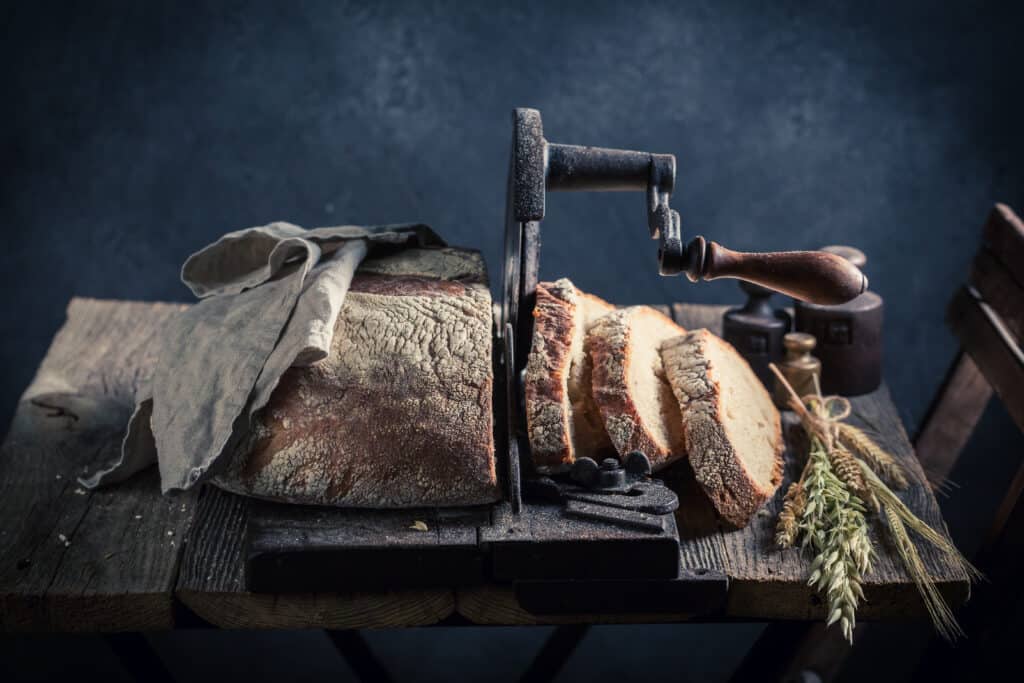Sliced bread has become the bedrock of many households, from sandwiches to homemade croutons, from pudding to Panzanella salad. Sliced bread is one of the most versatile foods known to humanity. But when was sliced bread invented? Who can claim they were the first to develop this revolutionary idea?
Sliced bread was first sold in 1928 by the Chillicothe Baking Company after Otto Frederick Rohwedder invented the first bread-slicing machine. Rohwedder’s first prototype in 1912 was destroyed in a fire, and it took Rohwedder an additional 16 years to redesign a fully functional machine in 1928.

Sliced bread truly is the best thing since, well, anything. We would be hard-pressed to think of a more influential invention outside massive technological leaps like semiconductors and the internal combustion engine. Let’s dive into the weird and wonderful history of sliced bread and “spread” some interesting facts about how sliced bread became so popular.
When Was Sliced Bread Invented?
The United States of America has proudly been the “first” on many occasions, the first airplane, the first human on the moon, and the first motor car. But few people remember that America was also the first to produce pre-sliced bread loaves.
According to Amber Waves in his 2004 book “Why Do Donuts Have Holes?” pre-sliced bread came into existence thanks to Otto Frederick Rohwedder. Waves’ says that Rohwedder knew people liked toasted bread but found it difficult to fit hand-sliced pieces of bread into the slots of early toasters. Thus, Rohwedder endeavored to create a machine that consistently slices pieces of bread of the same width.
Rohwedder’s first prototype bread-slicing machine went up in flames after his workshop burnt down in 1912. It would take Rohwedder an additional sixteen years before he made another functional bread-slicing machine in 1928. Local bakers weren’t very impressed with Rohwedder’s machine as its unrefined design left the loaves looking unappealing. Many called his machine’s cuts “sloppy.”
After Otto Frederick Rohwedder debuted his second bread-slicing machine, Gustav Papendick, a baker from St. Louis, purchased it and perfected its design. Papendick’s changes improved Rohwedder’s design by packaging the freshly sliced loaves in stiff cardboard trays and wrapping them in waxed paper.
At this point, factory-made bread was soft and proved difficult for people to slice with a bread knife. The invention of the bread-slicing machine introduced a new concept in pre-slicing bread and, more importantly, keeping it fresh!
Bakeries in early 1928 thought of pre-sliced bread as a “passing fad” and that pre-sliced bread would go stale much faster than whole loaves. They also thought people didn’t mind the inconvenience of slicing bread by hand if it meant their bread would last longer.
The Chillicothe Baking Company in Chillicothe, Missouri, was the first commercial bakery to use a bread-slicing machine on a large scale. Sales of pre-sliced bread were slow at first due to bakeries being unsure about the public’s acceptance of pre-sliced bread. Local bakeries thought buying new technology might be too costly if the people rejected the new concept.
Eventually, the “fad” and convenience of pre-sliced bread caught on, and sales increased by 2000%.
In 1930, the Continental Bread Company expanded the distribution of pre-sliced bread to the rest of the country under the “Wonder Bread” brand.
What Happened After Sliced Bread Was Invented?
Wonder Bread has been credited for its marketing campaign pushing sliced bread adoption nationwide. The idea of pre-sliced bread crossed the North Atlantic Ocean, and in 1937 Wonderloaf Bakery installed its first bread-slicing machine in Tottenham, London. By the early 1950s, almost 80% of all bread sold in Britain was pre-sliced.
Because sliced bread was thinner and more accessible than normal bread, the consumption of bread skyrocketed. Because people ate bread more frequently, the consumption of sandwich additions like jams also increased. This increase in bread consumption shows us that if you make a product easier to use, more people will use it more often.
Did People Slice Bread Before 1928?
People did indeed slice bread before 1928. According to historians, the earliest recording of bread dates back to around 8000 BC, with the most evidence coming out of Egypt. In the following centuries, many countries worldwide figured out how to make some variation of bread on their own.
People have been slicing bread by hand for as long as bread has been a thing. In medieval times white bread was considered a status symbol of the wealthy ruling class, and the “poor” got to eat rye, bran, and coarser bread.

3 Ways To Use Sliced Bread
Having pre-sliced bread in your pantry is one thing, but knowing how to use it is entirely different. Here are three ways to use sliced bread for dishes other than sandwiches.
1. Bread Pudding
Cubing or tearing a few slices of bread and adding some apples, fresh lemon juice, cinnamon, nutmeg, and a couple more ingredients can create a delicious apple bread pudding dessert.
2. Cheeseburgers Baked In The Oven
Sliced bread can be used as a substitute for hamburger buns. After all, there are no rules against using sliced bread when you feel like eating a cheeseburger. Grab a couple of slices of bread, slap on a nice thick piece of hamburger meat, cover it in cheese, and pop it in the oven. Simple, quick, and delicious.
3. Homemade Croutons
Sliced bread doesn’t stay fresh forever. This doesn’t mean that slightly stale bread becomes useless, though. Next time you can’t decide what to do with your day-old sliced bread, try cutting it into cubes, lathering it with some olive oil, and baking it in the oven. If you feel extra adventurous, try adding herbs and spices to your oil. Homemade croutons are perfect for a healthy on-the-go salad.
Conclusion
Sliced bread is truly great, and we can’t imagine a world without it. Thanks to Otto Frederick Rohwedder, we have been enjoying pre-sliced bread since 1928, and unless someone comes up with a better idea, we will probably enjoy sliced bread for another hundred years.
